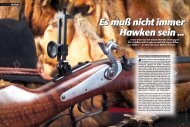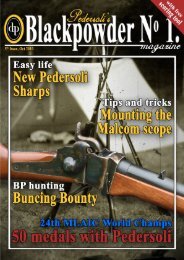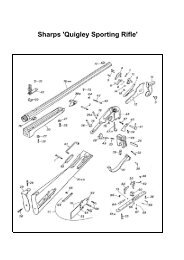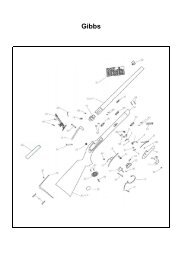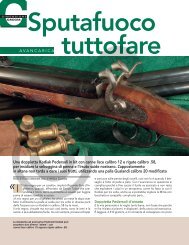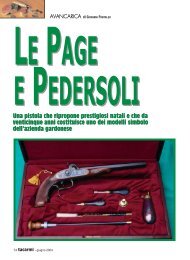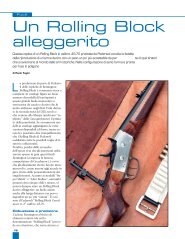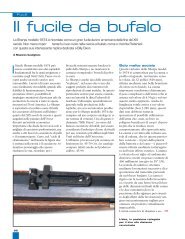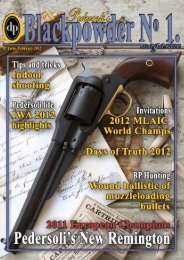“Gendellantios eum que sum volo dolorepta ... - Davide Pedersoli
“Gendellantios eum que sum volo dolorepta ... - Davide Pedersoli
“Gendellantios eum que sum volo dolorepta ... - Davide Pedersoli
Create successful ePaper yourself
Turn your PDF publications into a flip-book with our unique Google optimized e-Paper software.
[ FIREARMS ]<br />
<strong>Pedersoli</strong> <strong>Pedersoli</strong> Winchester Winchester 1886/71 1886/71<br />
Pete Pete Moore Moore looks looks at <strong>Pedersoli</strong>’s <strong>Pedersoli</strong>’s recreation recreation of the the Winchester Winchester 1886/71 1886/71 and and finds finds<br />
despite despite its its looks looks it’s it’s not not a cowboy cowboy rifle!<br />
rifle!<br />
With any new gun I test I always do<br />
some research, certainly certainly with the<br />
Wrecreation<br />
Wtime time line. With <strong>Pedersoli</strong>’s classic<br />
recreation of the Winchester 1886/71 you<br />
might well as<strong>sum</strong>e it was around in the<br />
generic western era, but as we shall see that<br />
is not the case.<br />
Up until the creation of the 1886<br />
Winchester’s legendary lever-actions all drew<br />
from the same wellspring – the original<br />
Volcanic. This was morphed into the Henry<br />
by B Tyler Henry, which in turn became the<br />
gate-loading Winchester 1866 and 1873. All<br />
in short pistol-type calibres Winchester<br />
beefed up and modifi ed the 73 to become<br />
the 1876 to offer a true big bore option.<br />
However, its toggle link locking system was<br />
about at its limit. With more powerful guns<br />
being offered by the opposition Winchester<br />
turned to John Moses Browning to give them<br />
a rifl e that could truly compete.<br />
THING OF BEAUTY!<br />
So the 1886 was born, which with its solid,<br />
though open-topped open-topped receiver and and rear<br />
locking action action proved the the inspiration inspiration for the<br />
Model 92 92 and 94, tube magazine lever-action<br />
rifl es. It was a strong design and offered<br />
such chamberings as 45-70 Govt, 45-90 and<br />
even the massive 50-110, 50-110, as well as the .33<br />
WCF (Winchester (Winchester Centre Fire). I had had a new<br />
1886 1886 which was the the rifl e e version with a<br />
2<br />
SHOOTING SPORTS MAGAZINE<br />
26” octagonal barrel, full-length magazine<br />
tube and pistol grip butt. It was modernmanufactured<br />
and made in 1999 by Miroku<br />
of Japan for Browning who by that time<br />
owned Winchester. It was also big and heavy<br />
fully bombed-up with 10-rounds (+1) of<br />
45-70 Government, but a thing of beauty!<br />
Today we seem to write off most<br />
lever-actions of this type as cowboy guns,<br />
which research showed was certainly not the<br />
case with the 1886/71 as it fi rst appeared<br />
in 1935 – 49-years after the original. It was<br />
also only offered in one calibre .348<br />
Winchester (8.8mm), which is a big,<br />
bottle-necked case based on a necked-down<br />
.50 WCF. There were originally three loadings<br />
- 150, 200 and 250-grains, which was<br />
reduced to just the one 200-grain later on.<br />
This however was generating a healthy<br />
2,530 fps/2,840 ft/lbs. The<br />
250-grainer made 2350<br />
fps/3060 ft/lbs, again<br />
respectable!<br />
PETE PETE MOORE MOORE SAYS: SAYS:<br />
SUCCESS OR FAILURE?<br />
The jury is out on whether the 71 was a<br />
success or failure. In essence essence it is is an 1886<br />
pretty pretty much re-introduced in 1935 in a more<br />
sporterised format, which stayed in<br />
production until 1957, so so on the books for<br />
22-years – not too bad. It It was however however<br />
starting to look a bit dated despite the US<br />
love affair with lever-actions. Add to this it<br />
was only ever chambered in 348<br />
Winchester, which is more a big game<br />
cartridge than than a a deer round. Plus<br />
the open-topped open-topped action<br />
offered no way of<br />
mounting a a<br />
As every <strong>Pedersoli</strong><br />
offer an exceptional<br />
reproduction of a historical<br />
firearm, this is the standard<br />
grade rifle, but versions with<br />
colour case-hardened frame and<br />
better would is also available<br />
“Gendellantios “Gendellantios “Gendellantios “Gendellantios <strong>eum</strong> <strong>eum</strong> <strong>eum</strong> <strong>que</strong> <strong>que</strong> <strong>que</strong> <strong>sum</strong> <strong>sum</strong> <strong>sum</strong><br />
<strong>volo</strong> <strong>volo</strong> <strong>volo</strong> <strong>volo</strong> <strong>dolorepta</strong> <strong>dolorepta</strong> <strong>dolorepta</strong> <strong>dolorepta</strong> <strong>dolorepta</strong> nulparitis nulparitis nulparitis nulparitis nulparitis<br />
pore pore pore pore delibus delibus delibus delibus delibus rem rem rem rem qui qui qui qui repudae repudae repudae repudae repudae<br />
<strong>sum</strong> <strong>sum</strong> andisqui andisqui andisqui aut aut quam quam quam hil hil expe” expe” expe”
scope, something Marlin Marlin with their 1894 and<br />
later 1895 did with their solid receiver build<br />
the latter in calibres such as 45-70<br />
Government.<br />
Government.<br />
So <strong>Pedersoli</strong>’s choice of reproducing the<br />
71 as opposed to the the original 1886 does<br />
seem a little odd odd and and despite being a classic classic<br />
design this this is is much more a hunting tool than<br />
a rifl e for punching paper at the the Trafalgar<br />
meeting! This is also attested to to by the the fact<br />
they also offer a barrel-mounted base that<br />
replaces replaces the the rear sight sight so so allowing allowing the fi tting<br />
of a red dot or even intermediate eye<br />
relief scope. Currently only<br />
chambered in 45-70 Government this would<br />
make a a great choice for driven boar or<br />
close-in big game game work. work. As despite its age<br />
this calibre calibre is a serious contender and with<br />
the introduction introduction of new ammo from Hornady<br />
with their their Leverevolution series it offers<br />
some hi-tech performance performance for a round that that is<br />
138-years old and still going strong...<br />
Checking out their website now shows shows two,<br />
19” carbine versions called Boar Busters<br />
and fi tted as standard with the scope base,<br />
which includes a basic rear sight too. Also<br />
chambered in in 444 Marlin one is even in<br />
blaze camo, which does look odd on what<br />
was originally a classic rifl e. e.<br />
HANDS ON<br />
As always <strong>Pedersoli</strong> makes a superior<br />
product and the 1886/71 is no exception. I<br />
have have the the Standard Standard version on test that<br />
shows shows well blued barrel, magazine, action action<br />
and operating lever. The woodwork woodwork is two<br />
nice nice pieces pieces of che<strong>que</strong>red walnut with what<br />
appears to be a hi-lustre oil fi nish. The<br />
pistol-grip type butt is is wide and deep with a<br />
23mm, Ultra light, Microcell memory recoil<br />
pad pad that does not look out out of place and is to<br />
be appreciated! QD sling sling loops are located<br />
at the tip of the forend and under the butt.<br />
The Premium version is identical but shows<br />
a colour case-hardened action and better<br />
grade timber!<br />
The medium weight barrel is 24” with a<br />
1-18” twist rate to to suit large, slow moving<br />
bullets. At 7.5 lbs this is not a heavy rifl e<br />
though well sized at 42.5” 42.5” muzzle muzzle to butt.<br />
WE WE RECKON RECKON<br />
✹ Beautiful recreation of a classic<br />
big bore lever-action<br />
✹ Dedicated design which is more<br />
hunting than target<br />
✹ Reassuringly expensive...<br />
Unlike earlier lever-actions the 1886 locked by twin vertical lugs at the rear of the receiver,<br />
which for its day offered a very strong action, also note the holes for the aperture sight<br />
(Above) The Browning-designed 1886 was<br />
Winchesters first true big bore lever-action,<br />
the the 86/71 holds holds 5-rounds (Right) Old and and<br />
new left - classic 405-grain lead flat nose<br />
loading, right – the flexible flexible rubber rubber tip of<br />
the the 325-grain Leverevolution bullet<br />
138-years young, for hunting Hornady’s Leverevolution ammo really improves what the rifle can<br />
do no end<br />
3<br />
▲
▲<br />
[ FIREARMS ]<br />
The rear sight is a standard, semi-buckhorn elevator wedge type and is good<br />
out to 100-yards<br />
Sights consist of a semi buckhorn elevator/<br />
wedge at the rear - this can be removed<br />
when fi tting the scope base - and there are<br />
also two threaded holes for mounting already<br />
cut into the barrel. A brass-tipped blade in a<br />
removable tunnel sits up front.<br />
The bolt is rectangular and locks by twin<br />
vertical lugs at the rear. The open-topped<br />
receiver does not allow for scope mounting<br />
over the action, as ejection is straight up and<br />
back. But as with the original the rear of the<br />
bolt is drilled and tapped and <strong>Pedersoli</strong> offer<br />
an aperture sight to suit. The rifl e loads on<br />
the right via a sprung gate to a capacity of<br />
fi ve, plus one in the chamber. There’s is no<br />
separate safety catch as found on the<br />
Browning/Miroku 1886, which is located on<br />
the tang. Instead the hammer offers a half<br />
cock option that lifts it clear of the tail of the<br />
fi ring pin for a safe carry that is easy to<br />
TECHNICAL SPECIFICATIONS<br />
■ Name <strong>Pedersoli</strong> 1886/71 (S 740) Standard version<br />
■ Calibre 45-70 Government<br />
■ Capacity 5+1<br />
■ Action lever<br />
■ Barrel 24”<br />
■ Weight 7.5 lbs<br />
■ Length 42.5”<br />
■ Sights Y<br />
■ Barrel drilled and tapped for base<br />
■ Price £???<br />
■ Contact Henry Krank & Co Ltd, 0113 256 9163<br />
■ www.davide-pedersoli.com<br />
■ Lee Precision, bullets and brass – Henry Krank<br />
■ www.leeprecision.com<br />
■ Hornady Leverevolution ammo – Edgar Brothers Ltd,<br />
01625 613177<br />
■ www.hornady.com<br />
4<br />
SHOOTING SPORTS MAGAZINE<br />
thumb back into action. The operating<br />
lever is curved to conform to the shape of<br />
the pistol grip.<br />
GRADE 2<br />
Given the age of the 45-70 cartridge,<br />
fi rearms manufacture has moved on<br />
considerably since then and today you can<br />
very much put rifl es chambered for it into<br />
four distinct bands as to the power of the<br />
ammunition and strength of the action.<br />
Band 1 - original and reproduction BPCRs<br />
like the Sharps and trapdoor Springfi elds<br />
etc, Band 2 - lever-actions like the various<br />
1886s, Band 3 - Marlin 1895 lever-action<br />
and Band 4 - Ruger #1 single shot and the<br />
few bolt actions available. This is really<br />
only of concern to handloaders as all<br />
45-70 factory ammo is made with the<br />
weaker, Grade 1 actions in mind. Though<br />
is still more than capable of delivering the<br />
goods on big animals!<br />
As a 45-70 shooter I loaded up some<br />
Band 1 loads for the 71 using Lee<br />
Precision dies with 405-grain lead fl at<br />
nose bullets and brass all from Henry<br />
Krank & Co Ltd. This was with a maximum<br />
charge of 31-grains of Hodgdon H4198,<br />
which is producing around 1400 fps/1600<br />
ft/lbs. This makes a good practice/<br />
plinking load. But for hunting power I<br />
chose Hornady’s 325-grain Leverevolution<br />
ammo which uses a fl exible, polymertipped<br />
JSP-type bullet that is doing 2050<br />
fps/3032 ft/lbs at the muzzle. The<br />
pointed nose is ballistically more effi cient<br />
and can be safely used in a tube magazine<br />
Winchester 1886/71 <strong>Pedersoli</strong><br />
now recreates this classic leveraction<br />
sporter in 45-70, which is<br />
aimed more at the hunter<br />
Action open showing the locking lugs, the curvature of the lever does tend<br />
to push on the middle finger<br />
as the fl exible polymer tip will not detonate<br />
the primer above it under recoil. This<br />
design takes this calibre out of its short<br />
range/mediocre accuracy slot and improves<br />
it no end.<br />
A TAD LIVELY<br />
The 45-70 is a bit barky in light rifl es and the<br />
71 is no exception, especially when you are<br />
shifting heavy bullets of 400-grains +. I was<br />
very glad of the modern recoil pad as the<br />
lead loads if anything kicked more than the<br />
lighter and faster Leverevolution ammo. With<br />
iron sight you can expect 1-2” at 50-yards<br />
and 3-4 at 100, obviously a scope would<br />
improve that and I would say shots over<br />
250-yards on game are easily achievable.<br />
Operation was initially a little fi rm and<br />
the curved face of the lever tended to place<br />
pressure on your middle fi nger as you cycled<br />
the action. However, this smoothed up a<br />
little, but as a matter of course I would wear<br />
a shooting glove.<br />
For me the 71 would primarily be a boar<br />
rifl e or for big game in close cover. Those<br />
big/heavy bullets carry serious weight and<br />
energy that belies their apparently low<br />
launch speed. Add in the 5+1 capacity and<br />
the easy of fi lling of the magazine at any<br />
time along with an action that leaves both<br />
hands on the gun at all times and it’s all<br />
there! The down sides however are a classic<br />
design and a high price tag in what is a<br />
specialised rifl e.<br />
For more reviews like this<br />
www.gunmart.net



